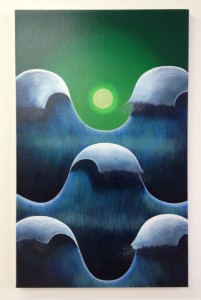Kristin Jensen’s ‘Vase Faces,’ are inanimate objects that appear to come to life, but the effect is more humorous homeyness than horror. Ghostly but not spooky, chubby-cheeked visages seem to emerge and disappear on these simple vessels to charming effect. (At Nichelle Beauchene Gallery on the Lower East Side through June 9th).
Kristin Jensen, ‘Face Vases 1-4, with Prologue,’ porcelain with celadon glaze, 2013.


































































































